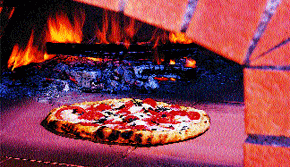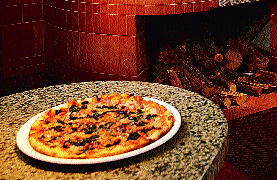
 |
|||||
|
|
|
|
|
|
|
The Glory of the Woodburning Ovenby Paul Etcheverry |
|
 Most of us take our pizza eating for granted. After all, at the moment of ingestion, all's right with the world. We're too busy searing the roof of the mouth with that succulent amalgamation of cheeses, meats, vegetables, mushrooms and tomato on crisp dough to ponder its genesis.
Most of us take our pizza eating for granted. After all, at the moment of ingestion, all's right with the world. We're too busy searing the roof of the mouth with that succulent amalgamation of cheeses, meats, vegetables, mushrooms and tomato on crisp dough to ponder its genesis.
The salient question is, would the type of oven make the difference between an indistinguishable blob of tomato sauce-laden dough and something crisp, delectable and memorable? Why can't you just shove the pizza in your microwave and be done with it? When the desire to understand how a genuine Italian pizza got that way extends beyond mere youthful dalliance into a chewy obsession nibbling at one's very soul, then investigate that staple of the honest-to-God Naples pizzeria, the wood-fired oven. Such unquenchable desire led me from my home in Santa Cruz, a few miles south to Mugnaini Imports' showroom and demonstration kitchen. Here, it's possible to get hands-on experience in the art of pizza cookery, as well as instruction from the company's fine support staff. I witnessed how foods cook directly on the clay floor of the 650 degree oven; in 2-3 minutes, a pizza sears on the outside to a nice crispy texture.
|

While company president and resident expert Andrea Mugnaini deftly prepared and cooked shittake mushroom and roasted pepper pizzas in no time flat, a crisp, golden brown opportunity to peruse genuine Italian ovens presented itself.
In the showroom, I examined a cutaway showing the oven's structure. Behind the oven's back side, you'll see a dome, bringing to mind a cozy little igloo (in truth, large enough to pass for an apartment in coveted Manhattan neighborhoods), with a flue in front as its "chimney". All ovens are constructed in overlapping modular pieces. This allows for the inevitable expansion/contraction and release of tension that transpires with the exchange of heat- after all, a one piece construction would crack. The smallest Refrattari Reggello oven had a four foot interior cooking diameter, the largest over six feet (which means you can roast a full-size turkey inside). Looking inside the front of the oven, the first thing you'll notice is a consistent radiant heat in the air- a sensation entirely different than that you would encounter examining a conventional oven. You might, on first glance, think that the wood fire is responsible for this. In fact, the material the oven is constructed from, a clay only available from the hills above Florence, provides the prime mover behind the whole process. "It's naturally quarried material," Ms. Mugnaini described, "that has the characteristics of absorbing heat, evenly distributing it and then retaining it for long periods of time. "The floor is very dense in relation to the overhead crown elements. So the thermal differential in the center actually forces the air to pull into a convection airflow pattern." The dome design and flue location enables uninterrupted hot air flow. So while the burning fuel provides the catalyst for the process, the oven cooks through a thermally efficient combination of radiant heat and airflow. Once the fire's in full swing, the "refractory terra cotta" and convection air flow does the rest. |
|
| |
|
Using a prefabricated Italian oven: How do you start an Italian wood-burning oven? First, build a small fire on the oven floor, center foreground. You ideally want a base of hot coals to ignite the logs. Start with pieces of dry kindling, one fire starter, then one-two 12 inch logs. Most hardwoods will do just fine, with the exception of the more resinous woods (pine, spruce, etc. ). Allow time for the fire to get going, gradually add four to six logs. It takes approximately two hours to bring the oven up to the 650-700 degrees Fahrenheit that is the right temperature for pizza. At that moment of prime "pizza readiness," brush the burning logs to the left or right side of the oven; you can concentrate them so that they take up very little space.
|
THE TEN COMMANDMENTS OF PIZZA
The Naples Pizza Association's Laws of pizza making Neapolitan style:
1. The dough must contain only flour, water, yeast, and salt. No fat is permitted. |
| pizza recipes | |
NEAPOLITAN-STYLE PIZZA DOUGH
Preparation: Flatten the dough with your fist. Cut the dough into 2 to 4 pieces and shape the pieces into balls. Dust the tops with flour. Place the balls on a floured surface and cover each with plastic wrap, allowing room for the dough to expand. Let rise 60 to 90 minutes, or until doubled.
SIMPLE PIZZA SAUCE
Ingredients: Preparation: In a large saucepan, combine the tomatoes, oil, and salt to taste. Bring to a simmer. cook, stirring occasionally, until thickened, 15 to 20 minutes. Let the sauce cool before spreading it on the pizza dough. |
PIZZA MARINARA Thirty to sixty minutes before baking the pizzas, place a baking stone or unglazed quarry tiles on a rack in the lowest level of the oven. Turn on the oven to the maximum temperature, 500° or 550° F. Place the dough on a floured surface. Holding your hands flat, pat the ball out evenly with your fingers, lifting it and turning it over several times, until it reaches a 9-inch circle. Do not handle the dough any more than is necessary. If the dough seems sticky, dust it lightly with flour. Dust a pizza peel or a rimless cookie sheet with flour. Carefully transfer the circle of dough to the peel. Shake the peel once or twice to make sure the dough does not stick. If it does, sprinkle the peel with more flour. Quickly top the dough with the sauce, spreading it to within 1/2 inch of the edge using the back of a spoon. Scatter the garlic and oregano over the sauce. Drizzle with the oil. To slide the pizza onto the prepared baking stone, line up the edge of the peel with the back edge of the stone, then tilt the peel, jerking it gently to start the pizza moving. Once the edge of the pizza touches the stone, carefully pull back on the peel until the pizza is completely off. Once the pizza is on the stone, do not attempt to move it until it firms up in 2 Or 3 minutes. Bake 6 to 7 minutes, or until the dough is crisp and browned. Serve immediately. 
|
|
|
||||
|
Copyright © 2008 Epicurean.com & Fezziwig Publishing Co. All rights reserved |